Introduction
Eczema (pronounced eg-zuh-muh), also known as atopic dermatitis, is one of the skin conditions under the branch of dermatitis.
Roughly translated, atopic dermatitis means “allergic inflamed skin”.
The exact cause of eczema is still unknown but is thought to be related to allergies, genetics, and the immune system.
Symptoms of eczema include itchy, dry skin, rashes, and red inflamed skin.
It can be chronic (long-lasting), but is non-contagious.
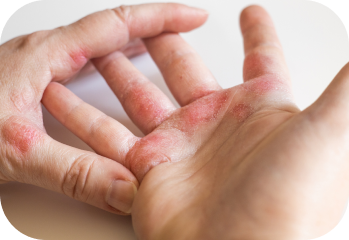
Atopic Dermatitis is more common in young children. 80% who have the condition experience symptoms before 6 years old. It is estimated to affect around 20% of children and 10% of adults. Exact data is hard to collect due to difficulties in treatment and data collection availability in different parts of the world.
Usually eczema rash or dry skin is found on the scalp, face, in creases of the skin, and the outsides of arms or legs. Symptoms can show up anywhere though.
Symptoms look different based on skin color. In darker skin tones it can look slightly purple, grey, brown, or red. You can see more by going to the eczema skin in color website.
Symptoms of Eczema
Eczema causes itching and inflammation.
Symptoms can occur anywhere on the body.
Severity can vary from mild to very intense, and the size of the area affected from small to large.
In extreme cases a person may be nearly fully covered, and intensely itchy from head to toe.
For some eczema is an irritating rash, and for others the experience overwhelms their ability to live a normal life.
Beyond itching and inflammation, there are several other symptoms that can result from eczema.
Dry skin is very common. People with eczema often lack the proper amount of lipids to retain moisture on the surface of their skin. Also, inflammation from an overactive immune system damages the skin and impedes its normal function.
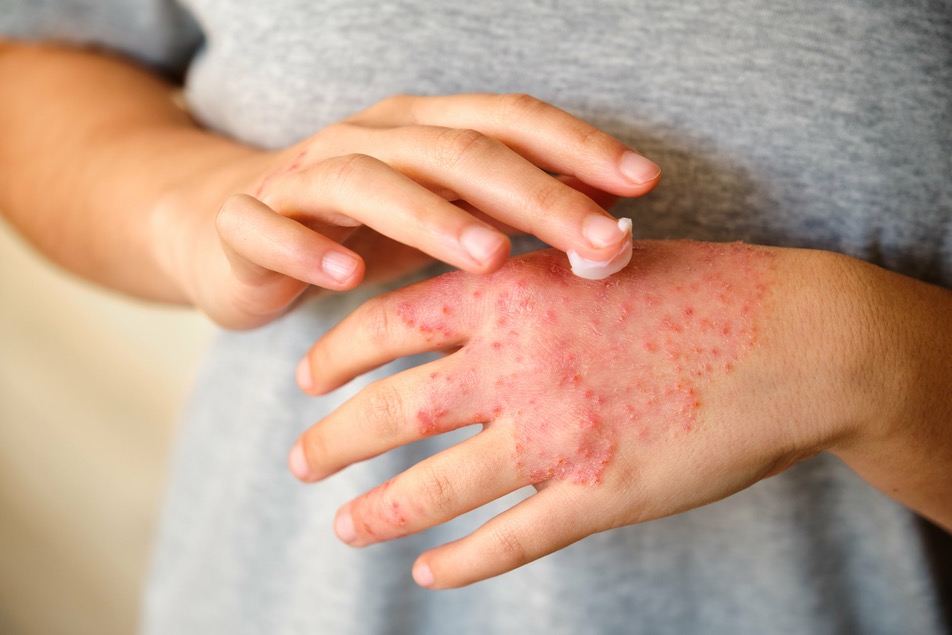
Patients can find themselves caught in a cycle from itching. When they scratch their skin for relief, the surface of the skin becomes damaged and it takes longer for the oil layer that should be on the outer layer to return. This exposes the skin to triggers, resulting in even more itching, and more dry skin.
Thick, leather-like/scaly skin patches can also be a symptom caused by eczema. When the skin is constantly damaged it can interrupt its ability to shed in a normal fashion.
Pain is a common symptom of eczema as well, resulting from constant itching, inflammation, and dryness.
Blisters may form with the potential to ooze and crust.
Papules may form, which are small bumps raised off the skin. They may be red, skin colored, or pink, and may be sore. Papules also form in other skin diseases like psoriasis.
Types of Dermatitis
Atopic Dermatitis is the most common form but there are many varieties.
Atopic Dermatitis is the most common form but there are many varieties.
- Contact Dermatitis
- Dyshidrotic Dermatitis
- Neurodermatitis
- Seborrheic Dermatitis
- Stasis Dermatitis
- Nummular Dermatitis

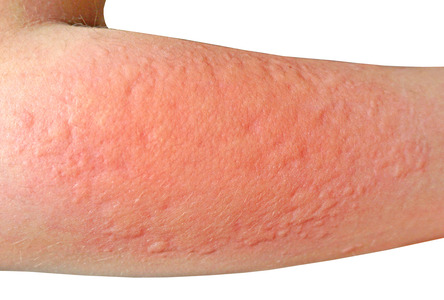
This dermatitis comes from an allergen or irritant coming into contact with the skin. It can look like a typical rash but the symptom severity might vary. It may include hives or even formation of blisters.

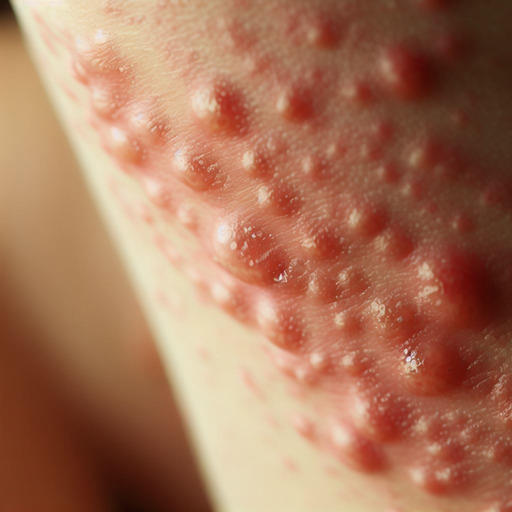
This form of eczema can result in blisters in between fingers, and on the sides of palms or soles of feet. Like eczema, dyshidrotic eczema also causes rashes, itching, and scaly skin.

Follow this link to see what neurodermatitis looks like
Known for scaly rash patches, leathery skin, and its tendency to only affect a relatively small surface area on the body, neurodermatitis is a fairly common form of dermatitis. When neurodermatitis is itched, it frequently intensifies immediately after.

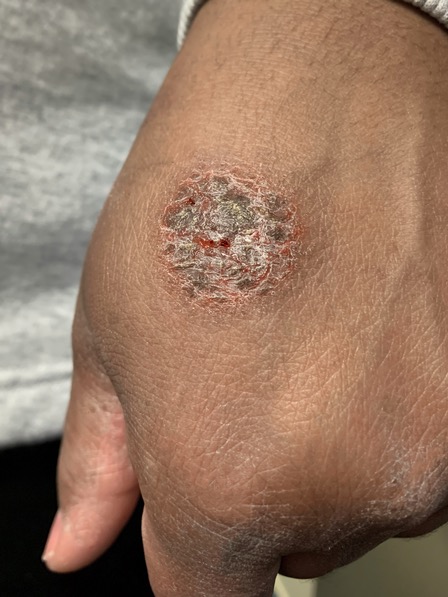
This dermatitis shows as a circular patch of raised, burning and itchy skin, often surrounded by more dry irritated skin. It looks somewhat like psoriasis.
Once diagnosed, it often requires aggressive treatment. In many cases symptoms are successfully treated. Nummular dermatitis can also be called discoid dermatitis, or discoid eczema.

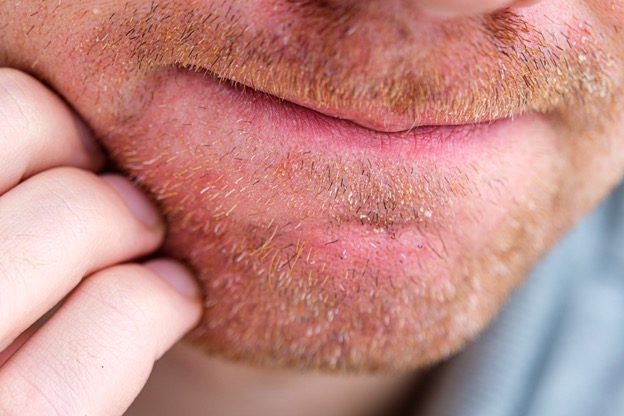
Typically contained to the scalp, and face due to their oily complexion, this type of dermatitis results in intense dandruff, itchy rashes, and patches of greasy flaky skin.

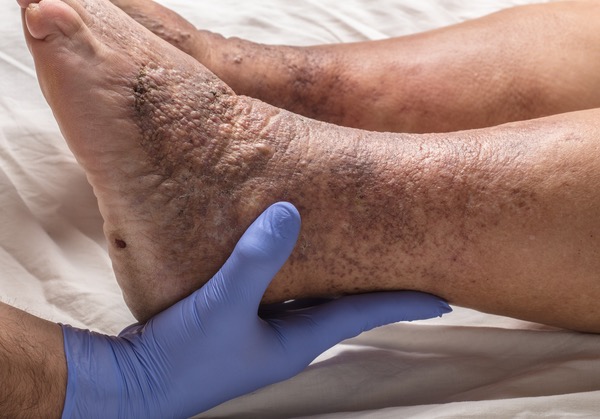
Caused by pooling of fluid in the lower legs, this form of dermatitis causes swelling, itching, dry skin, and sensitivity near the varicose veins. Typically this forms in older people as their leg muscles weaken.
Causes of Eczema
Genetics and Eczema
Scientists have known for a long time that genetics plays a role in the development of eczema. Studies have shown that a family history of eczema increases the likelihood of someone getting eczema.
Processes responsible for the integrity of the skin barrier can be affected by certain genetic variations, which lends to the development of eczema.
Understanding the likelihood of eczema being “passed on”, has proven to be complex, and it is suspected that multiple genetic variations create unique skin barrier and allergic challenges for the individual that interact with external triggers.
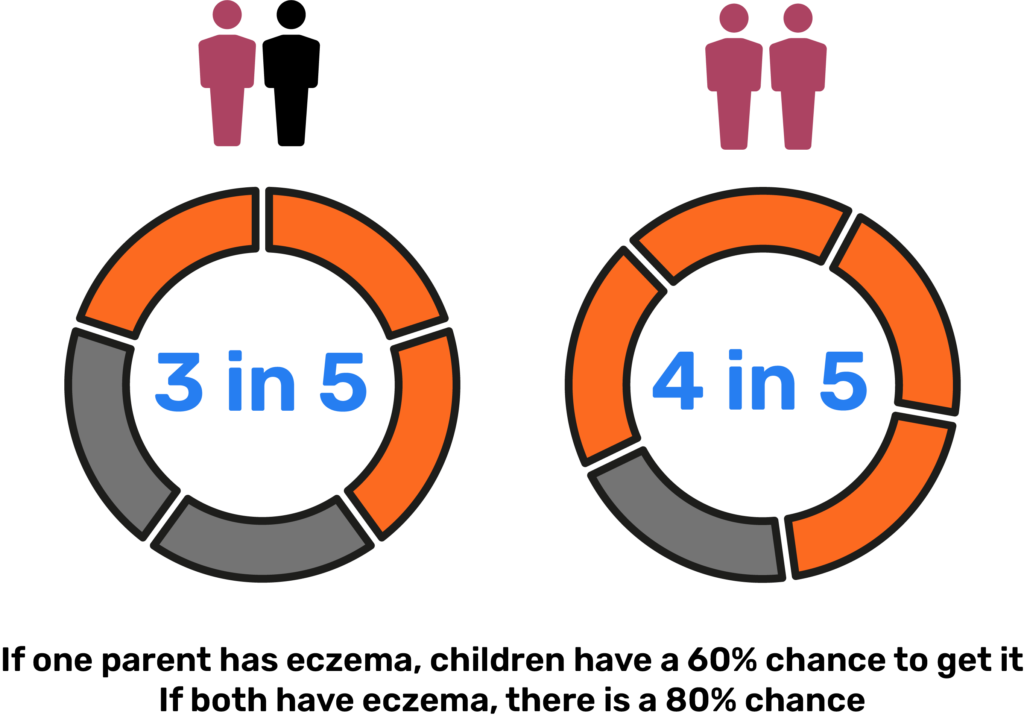
Immune System and Eczema
When someone has eczema their immune system may be prone to overreacting to external triggers.
An allergy (cat dander perhaps), mold, or even something as small and normal as dust can cause a severe allergic reaction.
It is suspected that variations in the immune system signal pathways can be determined by genetics.
Understanding the intricate mechanisms underlying immune dysfunction in eczema is crucial for developing targeted therapeutic strategies.
Skin Barrier Dysfunction and Eczema
Skin has three separate layers. At the top is the epidermis, which is responsible for the skin barrier.
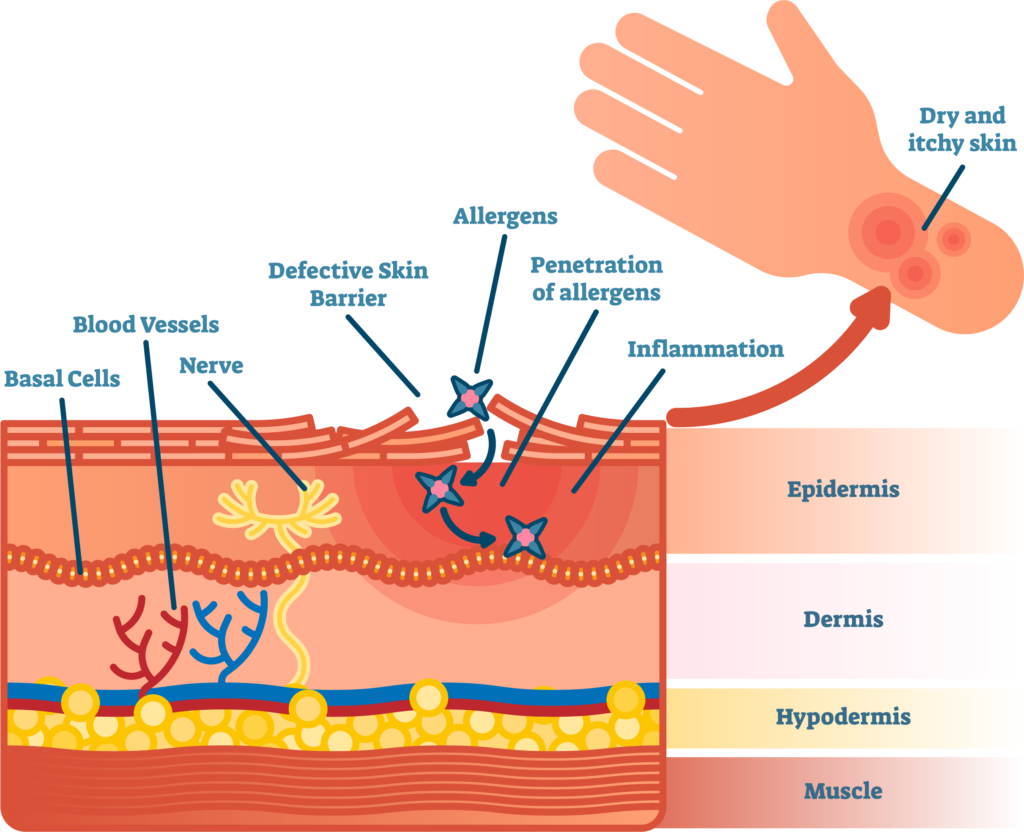
The Skin Barrier and Eczema
The skin barrier is naturally covered in a layer of oil which separates the skin from the rest of the world. In persons with eczema, there is some genetic variation that impedes the maintenance of a reliable skin barrier.
When the skin barrier is disrupted the layer of oil is no longer there. This results in outside triggers such as dust or allergens coming into direct contact with the skin. When external triggers touch the skin the immune system sends a signal through the body causing inflammation and itching.
Scratching the itch can lead to a destructive cycle of more itching and pain. It is known as the itch-scratch-itch cycle.
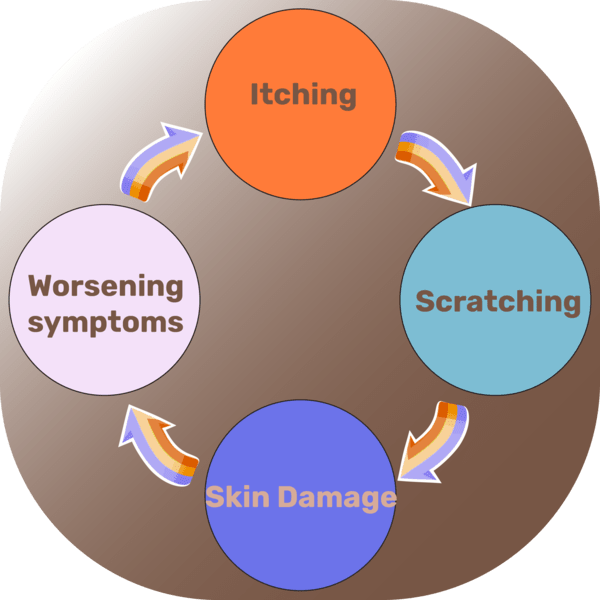
The Itch-Scratch-Itch Cycle
Environmental Factors and Eczema
Cold and hot air, wind, pollution, allergens, UV rays, and more, all influence skin barrier maintenance. What a person eats or drinks also plays a strong role in the health of their skin. Proper hydration, nutrition, as well as bad habits like drug use, or smoking, will all impact a person’s skin health. This means that a person with eczema must be mindful of how they treat their body or they cause flare-ups.
Allergens and Eczema
Allergens like mold, pollen, or pet dander can all make eczema worse. By triggering the immune system’s response they cause more inflammation and itchiness which feeds into the cycle of skin barrier damage. Food allergies can also cause flare-ups of eczema. The most common foods known for this are eggs, dairy, peanuts, and wheat, but it will depend entirely on the individual.
Identifying and avoiding allergens through allergen-specific testing and dietary modifications are essential components of eczema management. This is why many eczema patients visit an allergist to get help identifying their triggers. It’s also suggested to start a diary of triggers to avoid them.
Diagnosis
A dermatologist will first want to know about your family’s medical history with allergies and eczema. Since eczema is significantly affected by genetics it is always important to understand:
- Family history of allergies.
- Any history with hay-fever, asthma, or food allergies.
- Use of medications.
- Any triggers you may have noticed. Often certain soaps, perfumes, metals, or other irritants like cigarette smoke have a pronounced effect on people with eczema.
The dermatologist will then perform a visual exam of your skin. Since they are a skin doctor, they see cases of skin disease every day and are very experienced in diagnosing them. If once they have compared information about your medical history with their visual exam they still feel unsure they may order laboratory testing. These may include blood tests to check for other possible causes of your rash, or a biopsy of the affected area.
In a biopsy the doctors will freeze the affected area with a numbing agent, and then cut a small piece of the skin off for further testing.
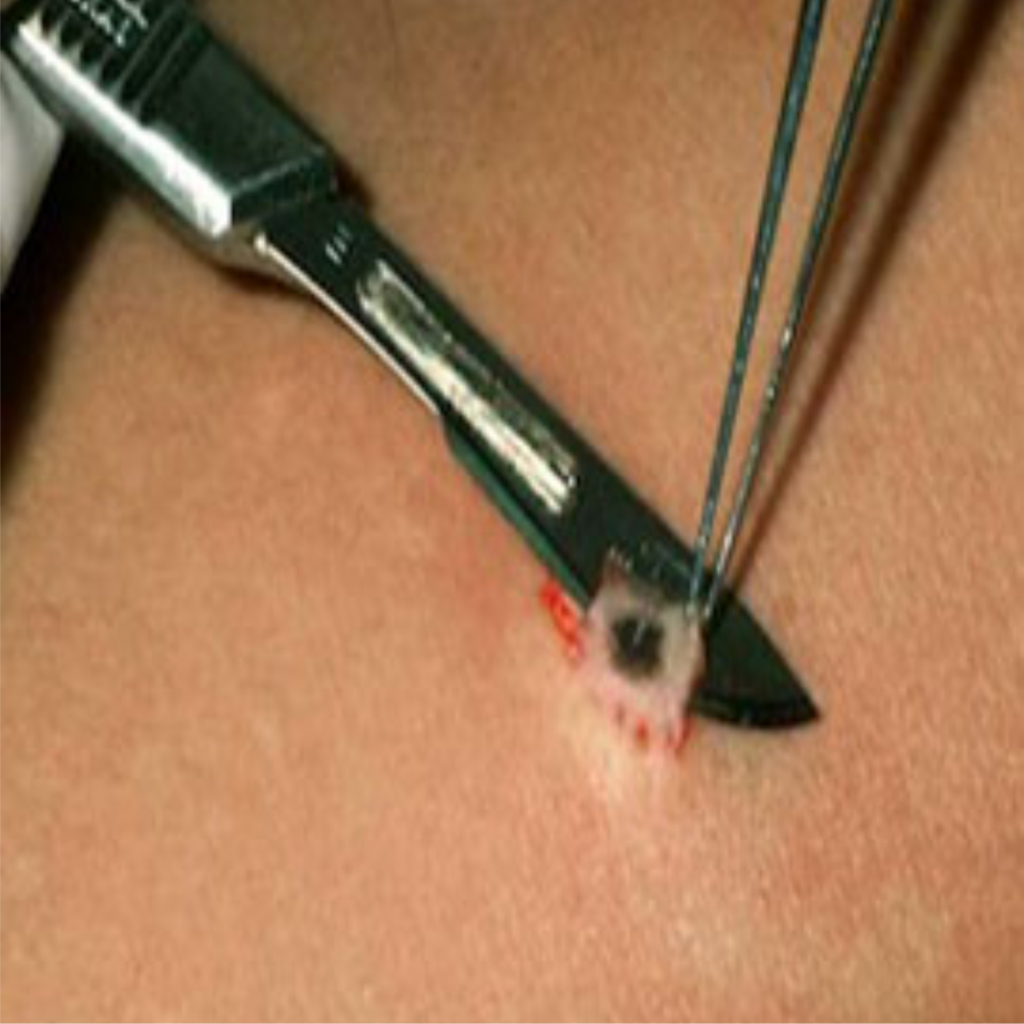
A biopsy. Numbing agent is used so there is no pain during the removal of the skin.
Treatment Options
Due to the variety of genetic causes and levels of severity of atopic dermatitis, every treatment plan should be personalized. In a mild case, you may be able to manage your symptoms by maintaining moisturization of the skin, avoiding triggers, and making dietary changes. We will explore this more in detail, but the general goals of treatment include: maintaining moisture in the skin, reducing the inflammation, controlling itching, promoting healing, and preventing infections and flare-ups.
It is extremely important to work with a dermatologist for specialized skin care treatment. There are many considerations at play, too many to list, and a dermatologist is not only highly educated, but vastly experienced in prescribing personalized plans for treatment.
Moisturizing
Moisturizing helps to repair the skin barrier, keep water in the skin, soothe irritation, and relieve the itching from eczema. Focusing on maintaining the moisture of the skin, avoid hot water and harsh soaps as they take away the oil from the skin. Apply moisturizer after bathing. Any areas where eczema tends to show up should be moisturized liberally as soon as they begin to become dry. It’s a good idea to ask your dermatologist about recommended moisturizers because they are not all equal. Some standard moisturizers are less effective for eczema than others and there are medical grade moisturizers.
Topical Steroids
These can come in many different forms. Medical corticosteroids mimic the effects of cortisone which is a natural hormone produced in our bodies. They are:
- Anti-Inflammatory
- Anti-Proliferative
- Vasoconstrictive
- Immunosuppresive.
They are most often prescribed as a lotion, a gel, a shampoo, or a cream, and applied directly onto the affected area. Steroids are usually highly effective at treating eczema. In some cases, however, eczema is too severe and resistant to this type of treatment. Historically, oral steroids were prescribed for severe cases, but since they have a “systemic” effect on the whole body and are often taken in higher doses the risk for side effects is greater. Steroids can also be injected for a powerful localized effect.
Patients should be aware of steroid withdrawal. Because steroids increase the level of the cortisone steroid in the body, the body senses this, and decreases natural production. If a person were to suddenly stop using steroids after a long time it would take the body some time to realize the change and adapt, leaving the body empty of these important hormones. The results can be extremely harmful to the patient. For this reason it’s important to follow directions from your dermatologist as closely as possible, because they will recommend the length of time, dosage, and methods for tapering off the use of steroids.
To learn more about steroids, click here for our article.
Emollients
One thing you might come across in your search for information on eczema are emollients. Emollients soothe and soften skin, and are often found as ingredients in moisturizers. While they don’t add moisture to the skin directly, they do help with restoring the skin barrier. By filling in gaps at the very surface of the skin they help prevent water loss. Emollients can also contain ingredients that promote the health of lipids that also contribute to maintaining the skin barrier.
Different emollients will work better for different people, depending on their specific skin needs. It is best to discuss any products you plan to use for treatment with your dermatologist as many can contain ingredients that lead to more harm than help and there will be specific ways to use them which are specific to your individual needs.
Calcineurin Inhibitors
Calcineurin is a protein that plays a role in the inflammatory response in the skin. By applying these inhibitors, often in the form of a topical cream, these drugs offer an alternative option for controlling eczema symptoms. Especially when other treatments haven’t been able to make a difference. They may be prescribed with topical steroids or as an alternative.
Phototherapy
Phototherapy, also known as light therapy, involves the controlled use of specific wavelengths of light to treat various skin conditions, including eczema. Phototherapy is often recommended for individuals with moderate to severe eczema who have not responded well to other treatments. Treatment typically happens twice or three times a week and can take a month or so to begin to show results.
It has been shown to reduce inflammation and itch and to be safe for use. In some cases it can provide full remission (no eczema). It is worth noting that the American Academy of Dermatology Association (AADA) has said that it may increase the risk of skin cancer, but that the risk itself seems very low.
Going to a tanning salon instead of a specific phototherapy center is a bad idea. Phototherapy is conducted with specific wavelengths of light and at specific levels of intensity, whereas tanning beds do not. Tanning can significantly increase the risk for skin cancer. It may even cause the skin to feel much worse. With phototherapy a dermatologist will monitor your progress and prescribe a specific treatment.
Biologics
When treating eczema, the primary function of a biologic is to block the immune system pathway that carries the signal to cause inflammation. For example, if an allergen comes into contact with the skin, the immune system is told to send a signal to the skin causing it to inflame and become itchy. Biologics will stop the signal and effectively block the inflammation deeper in the body.
Biologics come in different forms, often as sugars or proteins but they can even be living organisms. They are at the cutting-edge of medical innovation and can often be an option for those who have conditions that resist the normal lines of treatment.
This class of drug is not without side-effects. The common side effects are redness, itching, swelling, and pain. There could be a serious reaction which could cause pain, headaches, flushing, nausea or rashes. In rare cases, the most serious side effects are fever or chills, chest pain or tightness, high or low blood pressure, severe allergic reactions, or more swelling. Another down-side of biologics, is that like immunosuppressants, they dial down your immune system, which does not help with fighting colds, infections, or viruses.
Immunosuppressants
Immunosuppressants are a class of treatment reserved for treatment resistant cases of eczema. They have widely varying ways of working, but they all suppress the immune system response that causes inflammation and itching. Immunosuppressants carry serious risks of side-effects. That isn’t to say they will always cause them, but that they should only be used by a doctor’s orders, and with careful attention to how the doctor tells a person to use them.
The common immunosuppressants are: methotrexate, azathioprine, cyclosporine, mycophenolate mofetil (CellCept), and Tacrolimus (Protopic).
Antihistamines
Antihistamines are not considered a primary form of treatment, but some people find them helpful to break the itch-scratch-itch cycle by controlling flare-ups. Sedative antihistamines are the type that make people drowsy, and these can help to deal with the sleeplessness caused by eczema, but antihistamines do carry risks of side-effects. Over time the body also becomes resistant to antihistamines, so they should be used with caution.
Antihistamines should not be used by children without a doctors review. They should not be used by people with heart disease, bad blood pressure, heart rhythm problems, kidney or liver disease, glaucoma, or those with urinary retention problems. They may not be safe for pregnant or breastfeeding women.
Conclusion
There is no cure for eczema yet, but treatment options have advanced a lot even in the last 5 years alone. Clinical research is working, and there are many different options going through trials right now. With the infusion of AI into the clinical trial industry, many are expecting drug development to speed up and become more diverse in the types of treatments available.
Related Reading
References
https://acaai.org/allergies/allergic-conditions/skin-allergy/eczema/
https://my.clevelandclinic.org/health/diseases/9998-eczema
https://my.clevelandclinic.org/health/diseases/4089-dermatitis
https://www.dictionary.com/browse/atopic#
https://www.webmd.com/skin-problems-and-treatments/eczema/eczema-epidemiology
https://www.eczemacouncil.org/assets/docs/global-report-on-atopic-dermatitis-2022.pdf
https://www.mayoclinic.org/diseases-conditions/contact-dermatitis/symptoms-causes/syc-20352742#:~:text=Contact%20dermatitis%20is%20an%20itchy,up%20within%20days%20of%20exposure.
https://my.clevelandclinic.org/health/diseases/17728-dyshidrotic-eczema
https://www.mayoclinic.org/diseases-conditions/seborrheic-dermatitis/symptoms-causes/syc-20352710#:~:text=Seborrheic%20(seb%2Do%2DREE,%2C%20ears%2C%20eyelids%20and%20chest.
https://www.aad.org/public/diseases/eczema/types/stasis-dermatitis/symptoms
https://my.clevelandclinic.org/health/body/24425-lipids
https://www.niams.nih.gov/health-topics/atopic-dermatitis/diagnosis-treatment-and-steps-to-take
https://my.clevelandclinic.org/health/treatments/23305-emollients
https://www.nhs.uk/conditions/emollients/
https://www.aad.org/public/diseases/eczema/childhood/treating/phototherapy
https://www.fda.gov/about-fda/center-biologics-evaluation-and-research-cber/what-are-biologics-questions-and-answers
https://www.webmd.com/arthritis/psoriatic-arthritis/biologic-medications-and-side-effects
https://www.fda.gov/about-fda/center-biologics-evaluation-and-research-cber/what-are-biologics-questions-and-answers
https://www.healthline.com/health/eczema/antihistamines-for-eczema
https://www.webmd.com/skin-problems-and-treatments/eczema/eczema-antihistamineshttps://jamanetwork.com/journals/jamadermatology/article-abstract/2804875
SimcoDerm is a full service, comprehensive dermatology clinic located in Barrie. We provide our services to all the patients in Simcoe County and beyond.
Latest Tweets
Contact
- 105-5 Quarry Ridge Rd. Barrie, On, L4M 7G1
- Tel: (705) 503-6333
© 2024 SimcoDerm

